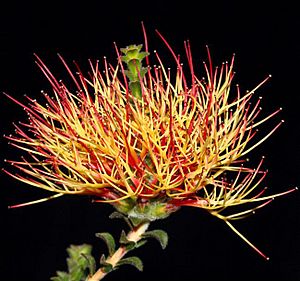Badgingarra beaufortia facts for kids
Quick facts for kids Badgingarra beaufortia |
|
|---|---|
 |
|
| Beaufortia bicolor near Coorow | |
| Conservation status | |
| Scientific classification | |
| Genus: |
Beaufortia (plant)
|
| Species: |
bicolor
|
| Synonyms | |
|
Melaleuca variegata Craven & R.D.Edwards |
|
The Badgingarra beaufortia (scientific name: Beaufortia bicolor) is a special plant found only in the south-west part of Western Australia. It's a type of shrub that belongs to the myrtle family, called Myrtaceae. This plant is known for its beautiful, bright flowers that are a mix of red, orange, and yellow. It usually blooms in November or December. Scientists have classified it as a "poorly known" species, which means they don't have a lot of information about it yet.
Contents
What Does the Badgingarra Beaufortia Look Like?
The Badgingarra beaufortia is a bushy shrub that can grow up to about 1 meter (3 feet) tall. It can also spread out to about 0.5 meters (1.5 feet) wide. It has rough bark that peels off. Its leaves are arranged in a special way, in opposite pairs, making four neat rows along the stems. The leaves are small, about 2.8 to 4 millimeters long and 1.2 to 1.9 millimeters wide. They are usually a bit hairy and have a unique shape, like a bird's wing, when you look at them closely.
The flowers of this plant are a mix of red, orange, and yellow. They grow in dense groups at the ends of the branches. Even after the flowers bloom, the branches keep growing! You might also see small tufts of white hairs mixed in with the flowers. Each flower has 5 sepals (small leaf-like parts), 5 petals, and 5 groups of stamens. Stamens are the parts that produce pollen. The stamens are usually yellow to orange at the bottom and turn red at the tips. They are joined together for about half their length. The plant flowers throughout the year, but mostly from October to January. After flowering, it produces small, woody seed pods called capsules. These capsules grow in small clusters around the stem.
How Was It Named?
The Badgingarra beaufortia was first officially described in 1987. A Swedish botanist named Arne Strid gave it its formal scientific name, Beaufortia bicolor. He described it in a scientific journal called Plant Systematics and Evolution. He found the first example of this plant near a place called Badgingarra.
Where Does It Grow?
You can find the Badgingarra beaufortia growing in Western Australia. It lives in the area between the cities of Perth and Geraldton. It prefers to grow in sandy areas, often where there is white sand over a type of rock called laterite.
Is It Protected?
The Western Australian Government's Department of Parks and Wildlife has classified the Badgingarra beaufortia as "Priority Three". This means that not much is known about this plant, and it's only found in a few places. However, it's not currently in immediate danger of disappearing. This classification helps scientists keep an eye on it and protect it for the future.


